Get ready to ring in the start of a new year with these New Year’s traditions from around the world.

New Year’s Eve festivities are unlike any other. Nothing beats the excitement of gearing up to welcome a brand new era surrounded by the most important people in our lives, fun music, and something good to toast with.
If there are chamoy appetizers aplenty and the bubbly keeps flowing, you know it’s gonna be a good time!
There’s no doubt that the final night of the calendar year is the perfect time to reflect on the past twelve months as we get ready for the future ahead, and most importantly, celebrate with our close friends and loved ones.
Why not start 2024 off right with a handful of classic New Year’s traditions mixed in with fun New Year’s superstitions from different corners of the world?
1. United States: Watch the Ball Drop on New Year’s Eve & Kiss At Midnight

Every year, on the evening of December 31st at exactly 11:59 p.m., hundreds of thousands of people gather around New York City’s One Times Square tower to watch the sparkling Waterford crystal ball drop. Billions others tune in from so many different parts of the world to watch this happen on TV.
Seeing the time-ball “drop” commemorates the passage of time and this magical tradition has remained a symbolic welcome to the New Year since it first descended in 1907.
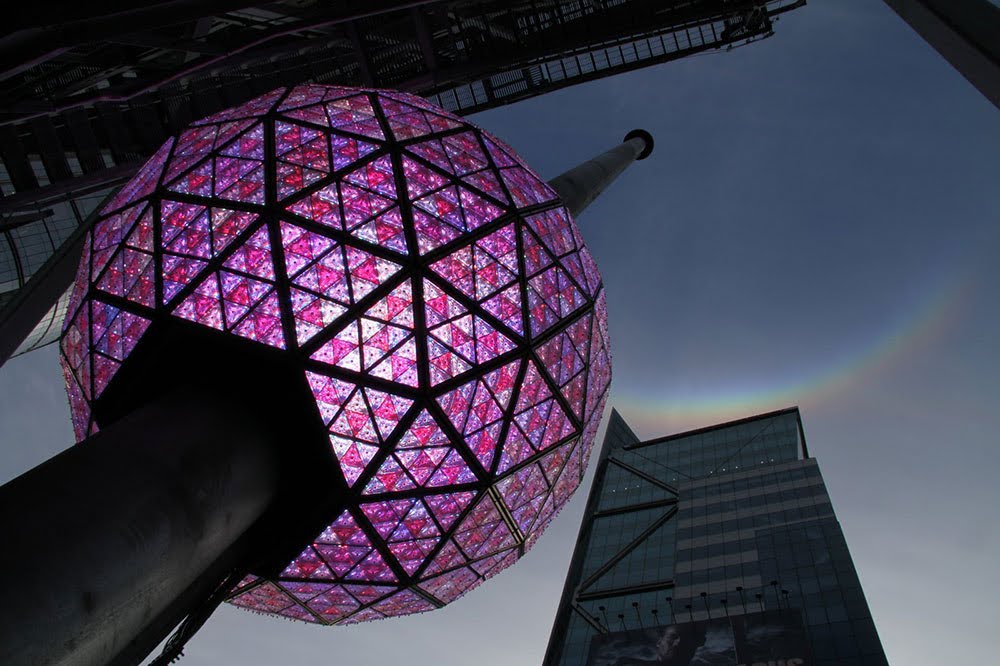
Whether in Times Square or in front of a screen, it’s nice to see the entire world coming together in countdown to the final seconds of the year in hopes that the upcoming one will be better. Just last year, the 2022 ball drop broadcast hit a high of 13.7M total viewers!
Today, the Ball Drop ceremony features special performances, ending with spectacular fireworks and the traditional kiss at midnight.
2. Brazil: Jump Seven Waves For Seven Wishes

Brazil’s warm summer weather invites its people to the beach to welcome the new year.
Following the motto “Ano novo, vida nova,” which means “New year, new life” families and friends gather together in massive parties that usually continue until sunrise on January 1st. In fact, around 2.9 million people filled Copacabana Beach to ring in 2020 in a celebration that started early in the evening and went on the whole night.
Afro-Brazilian religions Candomblé and Umbanda regard Iemanjá as a deity that protects the oceans and has rituals dedicated to her. Coastal cities ask Iemanjá for protection and peace in exchange for gifts like white flowers, soaps, combs, and necklaces.

Brazilians religiously wear white on New Year’s in hopes to attract protection and peace, and eat lentils for positive energy. Immediately after midnight, people jump seven waves and throw flowers into the ocean while making seven wishes. After the seventh jump, they return to the beach, without turning their backs on the sea.
3. Spain: Eat Twelve Lucky Grapes at Midnight
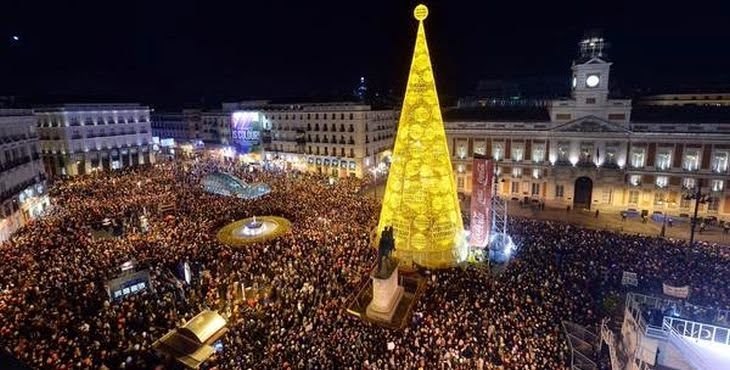
Spain is no stranger to superstition when it comes to New Year’s celebrations. Here longing for luck, love, and prosperity make traditions even more special.
As with so many things in Spanish culture, most New Year’s Eve traditions involve food. Spanish cuisine has everything you need to ring in the new year, from cava and cookies to lentils and grapes.
As the clock ticks down to midnight on New Year’s Eve, people across Spain pack into the plazas of their cities or into their homes to watch the clock chime. And, as the hour draws near midnight, everyone clings to twelve green grapes, or “las doce uvas de la suerte” (twelve lucky grapes).
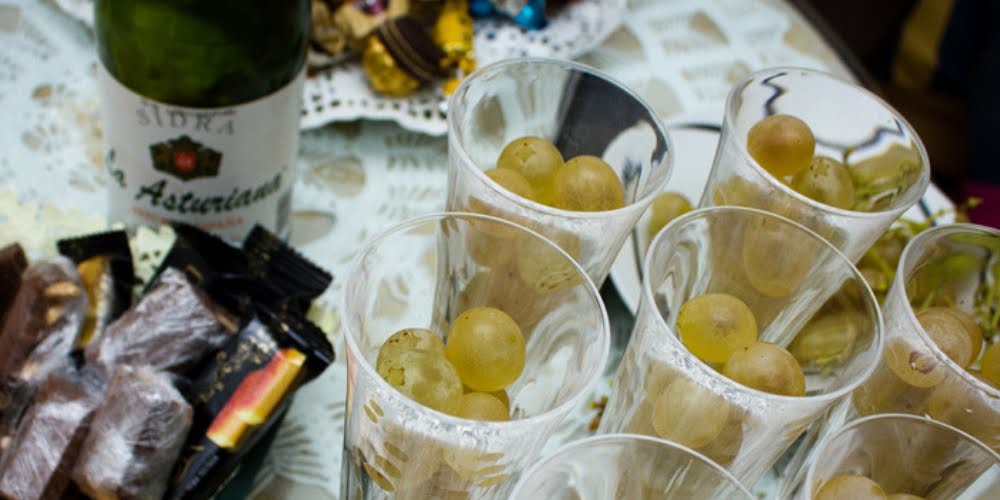
According to tradition, Spaniards try to eat one grape for every twelve clock chimes that ring in the new year at midnight before they stop ringing, each representing the 12 months of the year. You gotta believe us when we say it is much harder than it sounds…
Other New Year’s Eve traditions in Spain include eating lentil and chorizo soup for lunch (for good fortune), wearing red underwear (for love), and drinking an entire champagne glass with gold—think: wedding bands and coins going into the bubbling flute—after midnight.
While this tradition originated in 1895, it extended to other Hispanic countries and communities around the world, and remains a very important ritual today. Anything to add a bit of luck and excitement to champagne and fireworks on a cold winter night is fine by us!
4. Denmark: Shatter An Old Plate Against The Front Door
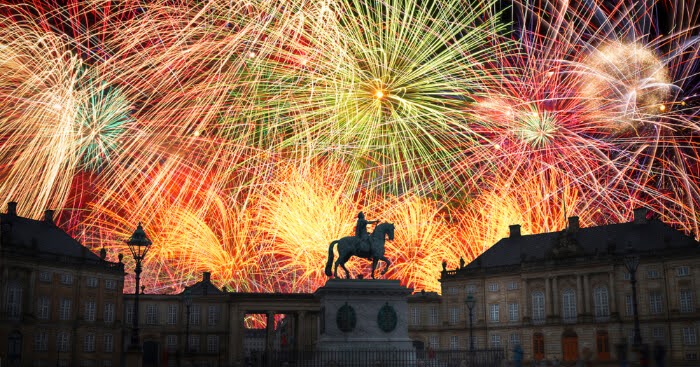
There’s a unique tradition in Denmark that happens yearly on the 31st of December.
Even though Greeks are famous for smashing plates during celebrations, Danes are known to smash plates against their friends and family’s doors to ring in the new year with good luck. This is also known as “smashing plates” or “plate smashing.”
We don’t know exactly when this tradition started, butplate smashing is believed to have started as a way to show appreciation for someone’s life. Smashing plates against someone’s door is a way to say thanks.
To prepare for plate smashing, Danes collect unused plates throughout the year. Some even decorate the plates with messages or drawings before smashing them.

Plate smashing is also thought of as a fun way to let go of the past and start fresh.
The act of breaking old dishes and plates symbolizes letting go of bad luck and negative energy and making way for new opportunities. The more plates you find outside your house, the more luck you’ll have in the New Year.
Other Danish New Year’s Eve traditions include gathering at popular landmarks, such as the City Hall Tower, and once the clock hands turn to midnight, watching the fireworks light up the sky.
5. Mexico: Throw Buckets of Water Out The Window & Walk Suitcases Outside Your Home
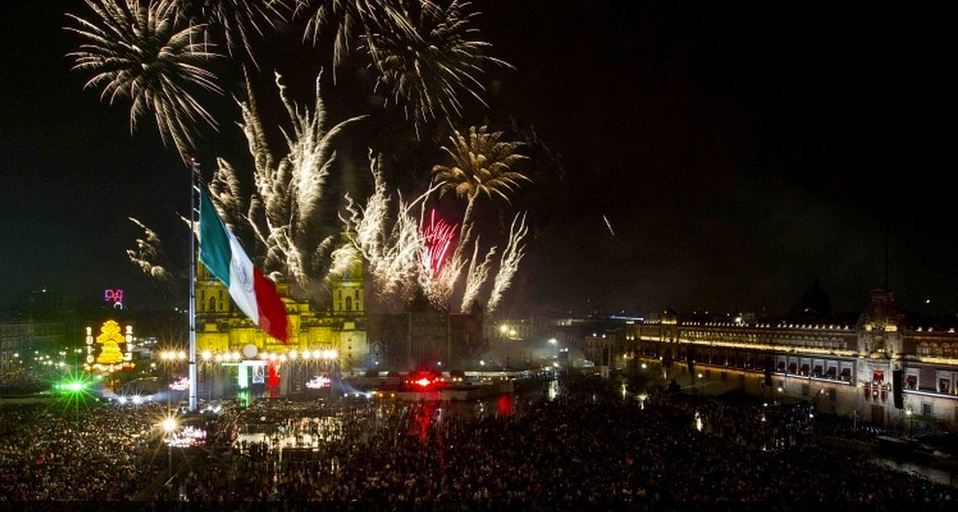
Every New Year’s Eve, Mexicans gather with close friends and family to wish each other love and prosperity. Our unique rituals and traditions happening before and after midnight to celebrate each blessing make our culture unique.
It’s easy to find a lot of similarities between Hispanic cultures, especially when it comes to New Year’s rituals: eating twelve lucky grapes at midnight, eating lentil soup for lunch, and throwing a bucket of water out the window to get rid of bad energy. And we can’t forget about wearing colored underwear depending on what you want for the new year ahead, such as green for wealth, red for love, and yellow for happiness.

One New Year’s Eve ritual in Mexico involves deep-cleaning the house before the new year starts, especially the corners and unused spots. This is thought to create the most welcoming environment for good energy and prosperity for the future. If Mexicans hope for lots of traveling in the year ahead, they’ll walk empty suitcases around the house at midnight, or even around the entire block.
Abundance Lambs are very popular New Year’s gifts for abundance and prosperity. The lamb must bring a bell to attract joy and prosperity, as well as a red ribbon around the neck to keep negative vibes away. Traditionally the lamb is passed along from one household to another and kept at the front door of the house throughout the year.
Do you have unique New Year’s Eve traditions? Let us know in the comments below!
